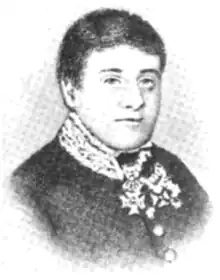Thomas Reade
Sir Thomas Reade (1782 – 1 August 1849) was a British army officer during the Napoleonic Wars, known also as a collector.[1]
Thomas Reade | |
|---|---|
 | |
| Born | 1782 |
| Died | 1 August 1849 (aged 66–67) Tunis, Tunisia |
| Occupation | Military officer |
| Spouse |
Agnes Clogg (m. 1824) |
In 1799, at the age of sixteen, he ran away from home to enlist in the army and participate in campaigns in Holland, Egypt and America, as well as postings across Europe. Reade was also a scholar and antiquarian and collected a range of artefacts, much of which are held in the British Museum today.[2]
He married Agnes Clogg on 8 September 1824.[3]
He was appointed consul general in Tunis on 10 May 1836, and died at his residence there on 1 August 1849.[3][4] Reade was also responsible for seriously damaging the Libyco-Punic Mausoleum of Dougga in 1842 for the purposes of stealing the monument's Libyco-Punic inscription.[5] The team commissioned to remove the inscription did it in such a maladroit way that the two upper floors of the mausoleum collapsed as a result.[6]
He is buried (or has a memorial) in Congleton Parish Church with a tomb sculpted by Thomas Gaffin.[7]
References
- Sir Thomas Reade (Biographical details) - British Museum
- Dr Jo Wright. "Sir Thomas Reade: The 'Nincumpoop' Collector of Arabic Manuscripts". Qatar Digital Library. Retrieved 28 January 2018.
- A St. Helena Who's Who. A. L. Humphreys. 1919. p. 117. Retrieved 20 July 2020 – via Google Books.
- "Tunis". The Daily News. 16 August 1849. p. 5. Retrieved 20 July 2020 – via Newspapers.com.
- "MWNF - Sharing History". sharinghistory.museumwnf.org. Retrieved 15 November 2022.
- "Thugga (Dougga), an ancient Roman town in today's Tunisia". www.romeartlover.it. Retrieved 15 November 2022.
- Dictionary of British Sculptors 1660-1851 by Rupert Gunnis p.160